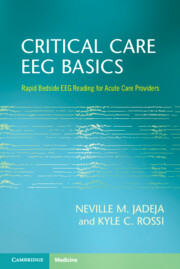Book contents
- Critical Care EEG Basics
- Critical Care EEG Basics
- Copyright page
- Dedication
- Contents
- Foreword
- Preface
- Acknowledgments
- How to Read This Book
- Part I Introduction
- Part II Case-Based Approach to Specific Conditions
- Chapter 9 Nonconvulsive Status Epilepticus (NCSE)
- Chapter 10 Management of the Ictal‐Interictal Continuum (IIC)
- Chapter 11 Seizures and Epileptiform Discharges
- Chapter 12 Seizure Mimics
- Chapter 13 Focal Lesions
- Chapter 14 Encephalopathy
- Chapter 15 Coma
- Appendix Understanding EEG Reports
- Index
- References
Chapter 12 - Seizure Mimics
from Part II - Case-Based Approach to Specific Conditions
Published online by Cambridge University Press: 22 February 2024
- Critical Care EEG Basics
- Critical Care EEG Basics
- Copyright page
- Dedication
- Contents
- Foreword
- Preface
- Acknowledgments
- How to Read This Book
- Part I Introduction
- Part II Case-Based Approach to Specific Conditions
- Chapter 9 Nonconvulsive Status Epilepticus (NCSE)
- Chapter 10 Management of the Ictal‐Interictal Continuum (IIC)
- Chapter 11 Seizures and Epileptiform Discharges
- Chapter 12 Seizure Mimics
- Chapter 13 Focal Lesions
- Chapter 14 Encephalopathy
- Chapter 15 Coma
- Appendix Understanding EEG Reports
- Index
- References
Summary
This chapter uses a case-based approach to describe a few common seizure mimics that may be mistaken for epileptic seizures in critically ill patients. These include tremors, myoclonus, syncope, and functional seizures (psychogenic non-epileptic seizures). Tremors appear as rhythmic or periodic activity but may be differentiated from seizures by the lack of a definite field and stereotyped pattern without evolution. Myoclonus refers to body or limb jerking movements that may be confused with seizures. Myoclonus may be of cortical or subcortical origin. Cortical myoclonus is associated with time-locked epileptic discharges, whereas subcortical myoclonus lacks an epileptic correlate though myogenic artifact may be seen. Convulsive syncope and non-epileptic psychogenic seizures are also described along with their electrographic patterns.
- Type
- Chapter
- Information
- Critical Care EEG BasicsRapid Bedside EEG Reading for Acute Care Providers, pp. 169 - 181Publisher: Cambridge University PressPrint publication year: 2024

